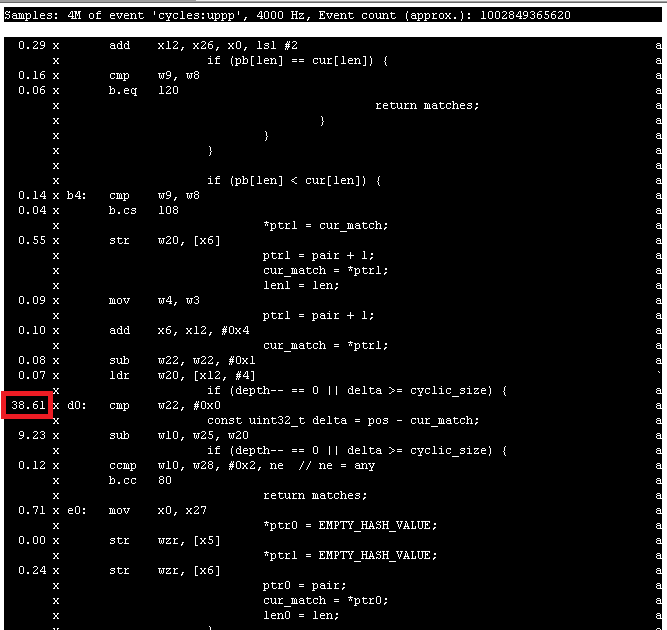Lab 6 continue
With the help of more than two of my classmates, results of lab 6 was produced
After examining the given code, and Professor's hint and suggestion. We were able to measure the time taken to manipulate the samples on each code, by timing the full code then subtract by the timing of the code without the code of manipulating the sample.
(Full code) - (Code without sample manipulating) = (code of manipulation)
The following information are time required for the code of manipulation
Conclusion
First, Xerxes is too powerful for this lab and can't be use to identify which method is faster.
Second, from every other machine test it turns out that the third method "Fix-point" was the fastest method. Which was surprising, during group lab every member conclude the second method "look-up table" would be the fastest.
After examining the given code, and Professor's hint and suggestion. We were able to measure the time taken to manipulate the samples on each code, by timing the full code then subtract by the timing of the code without the code of manipulating the sample.
(Full code) - (Code without sample manipulating) = (code of manipulation)
The following information are time required for the code of manipulation
| (Archie) | (Archie) 2 | |||
| aarchie.cdot.systems | aarchie.cdot.systems | |||
| vol 1 | vol 1 | |||
| real | 7.01 | real | 7.402 | |
| user | 7.547 | user | 7.611 | |
| sys | -0.6 | sys | -0.222 | |
| vol 2 | vol 2 | |||
| real | 12.547 | real | 12.614 | |
| user | 12.925 | user | 12.964 | |
| sys | -0.418 | sys | -0.388 | |
| vol 3 | vol 3 | |||
| real | 4.343 | real | 4.266 | |
| user | 4.164 | user | 3.943 | |
| sys | 2.203 | sys | 0.309 | |
| (Bbetty) | (Bbetty) 2 | |||
| 2200 ehl.cdot.systems | 2200 ehl.cdot.systems | |||
| vol 1 | vol 1 | |||
| real | 0.873 | real | 0.925 | |
| user | 0.887 | user | 0.892 | |
| sys | -0.01 | sys | 0.03 | |
| vol 2 | vol 2 | |||
| real | 0.935 | real | 1.426 | |
| user | 0.98 | user | 1.324 | |
| sys | -0.05 | sys | 0.1 | |
| vol 3 | vol 3 | |||
| real | 0.583 | real | 1.115 | |
| user | 0.584 | user | 1.058 | |
| sys | 0 | sys | 0.05 | |
| (Ccharlie) | (Ccharlie) 2 | |||
| 2205 ehl.cdot.systems | 2205 ehl.cdot.systems | |||
| vol 1 | vol 1 | |||
| real | 1.663 | real | 1.713 | |
| user | 1.643 | user | 1.764 | |
| sys | 0.03 | sys | -0.05 | |
| vol 2 | vol 2 | |||
| real | 2.508 | real | 2.536 | |
| user | 2.47 | user | 2.496 | |
| sys | 0.04 | sys | 0.03 | |
| vol 3 | vol 3 | |||
| real | 1.207 | real | 1.224 | |
| user | 1.184 | user | 1.216 | |
| sys | 0.02 | sys | 0.009 | |
| (Israel) | (Israel) 2 | |||
| israel.cdot.systems | israel.cdot.systems | |||
| vol 1 | vol 1 | |||
| real | 1.425 | real | 1.467 | |
| user | 1.415 | user | 1.455 | |
| sys | 0.005 | sys | 0.004 | |
| vol 2 | vol 2 | |||
| real | 2.49 | real | 2.562 | |
| user | 2.48 | user | 2.544 | |
| sys | 0.005 | sys | 0.016 | |
| vol 3 | vol 3 | |||
| real | 0.755 | real | 0.759 | |
| user | 0.735 | user | 0.742 | |
| sys | 0.017 | sys | 0.011 | |
| (Xerxes) | (Xerxes) 2 | |||
| xerxes.cdot.systems | xerxes.cdot.systems | |||
| vol 1 | vol 1 | |||
| real | 0.458 | real | 0.392 | |
| user | 0.467 | user | 0.401 | |
| sys | -0.01 | sys | -0.011 | |
| vol 2 | vol 2 | |||
| real | 0.291 | real | 0.406 | |
| user | 0.296 | user | 0.398 | |
| sys | -0.005 | sys | 0.008 | |
| vol 3 | vol 3 | |||
| real | 0.358 | real | 0.336 | |
| user | 0.368 | user | 0.355 | |
| sys | -0.011 | sys | -0.021 | |
Conclusion
First, Xerxes is too powerful for this lab and can't be use to identify which method is faster.
Second, from every other machine test it turns out that the third method "Fix-point" was the fastest method. Which was surprising, during group lab every member conclude the second method "look-up table" would be the fastest.


Comments
Post a Comment